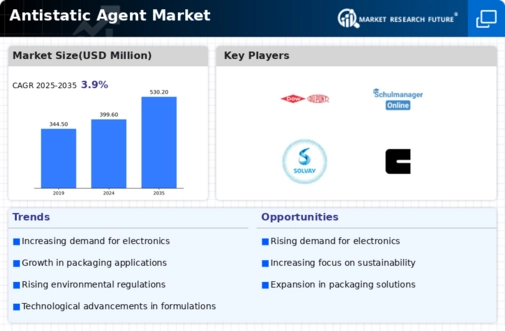Market Analysis
In-depth Analysis of Antistatic Agent Market Industry Landscape
In the dynamic Antistatic Agent Market, various market dynamics influence the industry's growth, trends, and competitive landscape. Here's an overview of the key market dynamics shaping the Antistatic Agent Market, presented in a paragraph with a pointer format:
Growing Demand in Plastics and Packaging Industries:
The Antistatic Agent Market experiences robust growth due to increasing demand from the plastics and packaging sectors. As these industries expand, the need for antistatic agents rises to address static electricity issues during manufacturing, processing, and packaging of plastic materials. Rising Adoption in Electronics and Textiles:
The electronics and textiles industries significantly contribute to the demand for antistatic agents. With the proliferation of electronic devices and the production of synthetic textiles, antistatic agents find widespread use in preventing electrostatic discharge and enhancing the overall quality of electronic components and fabrics. Technological Advancements and Product Innovations:
Ongoing technological advancements drive continuous innovation in antistatic agent formulations. Manufacturers focus on developing high-performance and sustainable antistatic agents to meet evolving industry requirements, including compatibility with various materials and adherence to environmental regulations. Increasing Awareness of Safety and Quality Standards:
Growing awareness of safety and quality standards prompts industries to prioritize the use of antistatic agents. Compliance with regulatory standards and the adoption of antistatic solutions become critical in ensuring product quality, safety, and meeting industry-specific requirements. Shift Towards Environmentally Friendly Solutions:
Environmental consciousness influences the Antistatic Agent Market, leading to a shift towards eco-friendly formulations. Manufacturers increasingly develop antistatic agents that are biodegradable and have minimal environmental impact, aligning with global sustainability trends. Globalization and Market Expansion:
The globalization of industries and increased international trade contribute to the expansion of the Antistatic Agent Market. Companies seek opportunities in emerging markets, driving the demand for antistatic agents in regions experiencing industrial growth and technological advancements. Fluctuating Raw Material Prices:
The Antistatic Agent Market is susceptible to fluctuations in raw material prices, primarily driven by petrochemical market dynamics. Variations in the costs of key ingredients impact production costs and, subsequently, product pricing within the antistatic agent industry. Stringent Regulatory Framework:
Stringent regulatory frameworks regarding chemical usage and environmental impact influence the Antistatic Agent Market. Compliance with regulations related to chemical safety and environmental standards becomes a crucial factor for manufacturers to maintain market access and credibility. Emergence of Smart Packaging Solutions:
The rise of smart packaging solutions, integrating technology into traditional packaging materials, influences the demand for antistatic agents. These agents play a role in ensuring the integrity of electronic components embedded in smart packaging, contributing to the growth of the Antistatic Agent Market. Increasing Application in Automotive Sector:
The automotive sector's expanding use of electronic components and reliance on advanced materials has led to an increased application of antistatic agents. These agents play a crucial role in preventing electrostatic discharge and maintaining the performance of electronic systems within vehicles. Competitive Landscape and Market Consolidation:
The Antistatic Agent Market witnesses competition among key players striving to gain a competitive edge. Market consolidation through mergers and acquisitions, strategic partnerships, and expansions allows companies to enhance their product portfolios, geographical reach, and overall market presence. Flammable Nature and Safety Concerns:
The flammable nature of some antistatic agents raises safety concerns in specific applications. Industries, particularly those involving potentially explosive atmospheres, carefully evaluate and adopt antistatic agents with appropriate safety features to mitigate risks associated with flammability. Impact of COVID-19 Pandemic:
The Antistatic Agent Market, like many other industries, experienced disruptions due to the COVID-19 pandemic. Supply chain challenges, reduced industrial activities, and shifts in consumer behavior influenced the market dynamics, requiring adaptability and resilience from industry players.







Leave a Comment